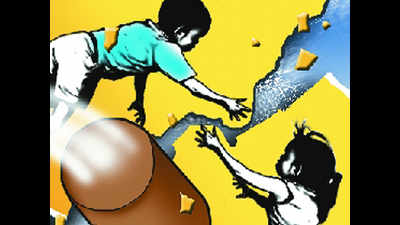Trending
This story is from June 23, 2017
Over 12,000 kids back from the brink in Nandurbar
Donkeys carried food to the remote areas of Nandurbar and parents had to be convinced about the treatment their children needed, but sustained efforts such as these for three years saved 12,000 children from malnourishment.

Representative image
PUNE: Donkeys carried food to the remote areas of Nandurbar and parents had to be convinced about the treatment their children needed, but sustained efforts such as these for three years saved 12,000 children from malnourishment.
Nandurbar is among the most backward districts with a large tribal population and always in the news for poverty, backwardness and malnourishment.
“There has been change in the last three years. Sincere efforts from the state government, UNICEF and communities are showing results,” Nandurbar district collector Mallinath Kalshetti told TOI.
“Doctors are unwilling to work here and the distance between hamlets and villages makes it impossible to cover all the areas. But we are going to continue the programme by getting more funds,” he added.
Government officials said international agencies are now focussing on the tribal district to study a community-based approach towards tackling malnourishment.
“We identify and screen children who meet the criteria and have received food. We carry out regular monitoring and conduct training programmes for people involved in the project. Our screening to identify a malnourished child is a continuous process. This particular model is the effort of the state, UNICEF and the local communities,” Rajeshwari Chandrasekar, chief of field office in Maharashtra, said.
Participatory efforts are showing good results and the programme should continue to benefit children via the government systems.
“It makes the programme unique in Nandurbar. Tata Trusts has played a big role in Nandurbar in the last few years as part of an MOU between the department of women and child development and UNICEF and then they procured internationally certified food packets to the SAM children,” she added.
Rural Maharashtra has 40% of children under the age of five years underweight, according to the National Family Health Survey 2015-16.
“We are aware that malnourishment is not an isolated issue. It is connected with poverty, education, and unemployment. But somewhere we have to step forward for a change,” Sunil Patil, a teacher from Nandurbar said.
“There are huge problems before us, but we have be positive approach and people are responding to change,” he further added.
Nandurbar is among the most backward districts with a large tribal population and always in the news for poverty, backwardness and malnourishment.
“There has been change in the last three years. Sincere efforts from the state government, UNICEF and communities are showing results,” Nandurbar district collector Mallinath Kalshetti told TOI.
“Doctors are unwilling to work here and the distance between hamlets and villages makes it impossible to cover all the areas. But we are going to continue the programme by getting more funds,” he added.
A community-based management of acute malnutrition programme is underway in Nandurbar district to assess the feasibility, efficacy and effectiveness of treating children with severe acute malnutrition using community-based care and special foods.
Government officials said international agencies are now focussing on the tribal district to study a community-based approach towards tackling malnourishment.
“We identify and screen children who meet the criteria and have received food. We carry out regular monitoring and conduct training programmes for people involved in the project. Our screening to identify a malnourished child is a continuous process. This particular model is the effort of the state, UNICEF and the local communities,” Rajeshwari Chandrasekar, chief of field office in Maharashtra, said.
Participatory efforts are showing good results and the programme should continue to benefit children via the government systems.
“It makes the programme unique in Nandurbar. Tata Trusts has played a big role in Nandurbar in the last few years as part of an MOU between the department of women and child development and UNICEF and then they procured internationally certified food packets to the SAM children,” she added.
Rural Maharashtra has 40% of children under the age of five years underweight, according to the National Family Health Survey 2015-16.
“We are aware that malnourishment is not an isolated issue. It is connected with poverty, education, and unemployment. But somewhere we have to step forward for a change,” Sunil Patil, a teacher from Nandurbar said.
“There are huge problems before us, but we have be positive approach and people are responding to change,” he further added.
End of Article
FOLLOW US ON SOCIAL MEDIA











